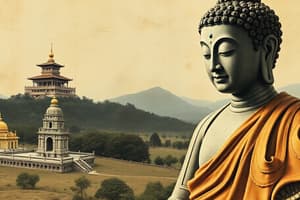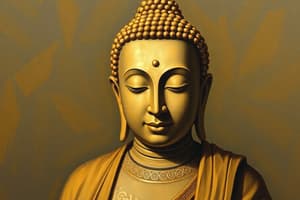Podcast
Questions and Answers
What is the birthplace of Siddhartha Gautam, the founder of Buddhism?
What is the birthplace of Siddhartha Gautam, the founder of Buddhism?
- Kapilvastu (correct)
- Bodhgaya
- Sarnath
- Kushinagar
What significant event is known as Dharma-Chakra-Pravartana?
What significant event is known as Dharma-Chakra-Pravartana?
- Buddha's enlightenment
- Buddha's death
- Buddha's ascetic lifestyle
- Buddha's first sermon (correct)
Which of the following is part of the Eightfold Path in Buddhism?
Which of the following is part of the Eightfold Path in Buddhism?
- Right temptation
- Right action (correct)
- Right outcome
- Right wisdom
What lifestyle did Siddhartha Gautam embrace after leaving his royal life?
What lifestyle did Siddhartha Gautam embrace after leaving his royal life?
At what age did Siddhartha Gautam attain enlightenment?
At what age did Siddhartha Gautam attain enlightenment?
According to Buddhism, what is the essence of the world?
According to Buddhism, what is the essence of the world?
What does the term 'Madhyam Marg' refer to in Buddhism?
What does the term 'Madhyam Marg' refer to in Buddhism?
Which of the following statements is true regarding the belief in deities in Buddhism?
Which of the following statements is true regarding the belief in deities in Buddhism?
What is the literal meaning of Mahayana?
What is the literal meaning of Mahayana?
Which of the following is NOT a belief of the Hinayana school?
Which of the following is NOT a belief of the Hinayana school?
Which school of Buddhism is closest to the original teachings of the Buddha?
Which school of Buddhism is closest to the original teachings of the Buddha?
Where did Vajrayana Buddhism primarily develop?
Where did Vajrayana Buddhism primarily develop?
What defining characteristic is associated with Zen Buddhism?
What defining characteristic is associated with Zen Buddhism?
What was the main purpose of the Sangha within Buddhism?
What was the main purpose of the Sangha within Buddhism?
Which event prompted Emperor Ashoka to adopt the policy of Dhamma conquest?
Which event prompted Emperor Ashoka to adopt the policy of Dhamma conquest?
Which of the following regions is NOT predominantly associated with Theravada Buddhism?
Which of the following regions is NOT predominantly associated with Theravada Buddhism?
Which area did Ashoka NOT send Buddhist missions to?
Which area did Ashoka NOT send Buddhist missions to?
What is considered the chief contribution of Buddhism to Indian culture?
What is considered the chief contribution of Buddhism to Indian culture?
Which of the following statements about Buddhism as a form of soft power is true?
Which of the following statements about Buddhism as a form of soft power is true?
Which of these universities is associated with the promotion of Buddhist education?
Which of these universities is associated with the promotion of Buddhist education?
What facilitated the spread of Indian culture to other parts of Asia through Buddhism?
What facilitated the spread of Indian culture to other parts of Asia through Buddhism?
Which values does Buddhism impart that are essential for Asian emotional bonding?
Which values does Buddhism impart that are essential for Asian emotional bonding?
Which initiative is suggested to enhance India's international association with Buddhism?
Which initiative is suggested to enhance India's international association with Buddhism?
What role does the Dalai Lama play in the context of Buddhism in India?
What role does the Dalai Lama play in the context of Buddhism in India?
What is nibbana in Buddhism?
What is nibbana in Buddhism?
Which of the following is NOT one of the Five Precepts in Buddhism?
Which of the following is NOT one of the Five Precepts in Buddhism?
What significant event occurred during the First Council of Buddhism?
What significant event occurred during the First Council of Buddhism?
Which Pitaka contains the main teachings or Dhamma of Buddha?
Which Pitaka contains the main teachings or Dhamma of Buddha?
Who presided over the Second Council of Buddhism?
Who presided over the Second Council of Buddhism?
What was a key outcome of the Buddhist Councils?
What was a key outcome of the Buddhist Councils?
Which text consists of the rules of conduct for monks and nuns?
Which text consists of the rules of conduct for monks and nuns?
In which year was the Third Council of Buddhism held?
In which year was the Third Council of Buddhism held?
Flashcards are hidden until you start studying
Study Notes
The Origins of Buddhism
- Buddhism originated in India over 2,600 years ago as a transformative way of life.
- Founded by Siddhartha Gautama, born in Lumbini near the Indo-Nepal border in circa 563 BCE.
- At 29, Gautama left his privileged life to pursue asceticism.
- After 49 days of meditation, he attained enlightenment at Bodhgaya in Bihar, under a pipal tree.
- His first sermon was delivered in Sarnath, near Benares, known as Dharma-Chakra-Pravartana (turning of the wheel of law).
- Buddha died at the age of 80 in 483 BCE in Kushinagara, an event known as Mahaparinibban.
Main Tenets of Buddhism
- Buddha advocated for the "Madhyam Marg" or middle path, avoiding extremes of indulgence and asceticism.
- He emphasized individual responsibility for happiness, highlighting the individualistic aspect of Buddhism.
- The core teachings are encapsulated in the Four Noble Truths (ariya-sachchani) and the Eightfold Path (astangika marg).
Four Noble Truths
- Suffering (dukkha) is inherent in the world.
- Suffering has a cause (Samudya).
- Suffering can be extinguished (Nirodha).
- This can be achieved through the Eightfold Path.
Eightfold Path
-
Right view
-
Right intention
-
Right speech
-
Right action
-
Right livelihood
-
Right mindfulness
-
Right effort
-
Right concentration
-
The essence of Buddhism is attaining enlightenment, avoiding self-indulgence and self-denial.
-
There is no supreme god or deity in Buddhism.
-
The ultimate goal is attaining nibbana, an experience, not a place.
-
Buddha established codes of conduct for monks and laypeople called the Five Precepts or Pancasil:
- Avoiding violence
- Refraining from stealing
- Avoiding sexual misconduct
- Avoiding lying or gossip
- Avoiding intoxicating substances (drugs or drink)
Major Buddhist Texts
- Buddha's teachings were originally oral, memorized by the Sangha and passed down through recitations.
- They were formally codified and divided into three Pitakas at the First Council in 483 BCE.
- The teachings were written down around 25 BCE in Pali.
Three Pitakas
-
Vinaya Pitaka: Rules of conduct and discipline for monks and nuns.
-
Sutta Pitaka: Main teachings (Dhamma) of Buddha, divided into five Nikayas:
- Digha Nikaya
- Majjhima Nikaya
- Samyutta Nikaya
- Anguttara Nikaya
- Khuddaka Nikaya
-
Abhidamma Pitaka: Philosophical analysis and systematization of teachings and monastic scholarly activity.
-
Other important Buddhist texts include:
- Divyavadana
- Dipavamsa
- Mahavamsa
- Milind Panha etc.
Buddhist Councils
- Marked significant turning points in early Buddhism.
- Contributed to sectarian clashes and eventually the Great Schism, leading to Theravada and Mahayana schools.
- Four major councils were convened:
First Council
- Held soon after Buddha's death in 483 BCE under King Ajatshatru.
- Presided by Mahakasyapa.
- Held at the Sattapani cave in Rajgriha.
- Purpose was to preserve Buddha's teachings and rules for disciples.
- Divided teachings into three Pitakas.
Second Council
- Held in Vaishali, Bihar, in 383 BCE under King Kalasoka.
- Presided by Sabakami.
Third Council
- Held in Patliputra in 250 BCE under Ashoka.
- Presided by Moggaliputta Tissa.
Fourth Council
- Held in 72 AD at Kundalvana, Kashmir.
- Presided by Vasumitra, with Asvaghosa as deputy, under King Kanishka of Kushan.
- Contributed to the division of Buddhism into Mahayana and Hinayana.
Schools of Buddhism
- Two Main Schools:
Mahayana
- "Great Vehicle", emphasizes the heavenliness of Buddha and idol worship of Buddha and Bodhisattvas embodying Buddha Nature.
- Originated in Northern India and Kashmir, spreading to Central Asia, East Asia, and Southeast Asia.
- Includes Buddhist traditions in China, Korea, Tibet, and Japan.
Hinayana
- "Lesser Vehicle", emphasizing original teachings of Buddha or the "Doctrine of elders".
- Doesn't believe in idol worship and focuses on individual salvation through discipline and meditation.
- Theravada is a Hinayana sect.
Theravada
- Oldest extant branch of Buddhism.
- Closest to original teachings of Buddha.
- Developed in Sri Lanka and spread to Southeast Asia.
- Dominant religion in Cambodia, Laos, Myanmar, Sri Lanka, and Thailand.
Vajrayana
- "Vehicle of the Thunderbolt", also known as Tantric Buddhism.
- Developed in India around 900 CE.
- Emphasizes esoteric elements and complex rituals compared to other schools.
Zen
- School of Mahayana Buddhism, originated in China as the Chan school.
- Developed into various schools and spread to Japan in 7th century.
- Distinctive feature is meditation.
Spread of Buddhism
- Buddha had monks (bhikshus) and lay worshippers (upasikas).
- Monks were organized into the Sangha to spread teachings.
- The Sangha was democratic and enforced discipline.
- Buddhism spread rapidly in North India during Buddha's lifetime.
- Following Buddha's death, his followers continued to spread his teachings.
- For 200 years, Buddhism was overshadowed by Hinduism until the reign of Ashoka.
- After the Kalinga conquest, Ashoka embraced Dhamma conquest and sent missions to Gandhara, Kashmir, Greece, Sri Lanka, Burma, Egypt, and Thailand.
- Ashoka's efforts transformed a local sect into a world religion.
Buddhism's Contribution to Indian Culture
- Key contribution: The concept of ahimsa (non-violence).
- Significant contributions to art and architecture: Stupas at Sanchi, Bharhut, and Gaya.
- Promoted education through residential universities like Taxila, Nalanda, and Vikramasila.
- Developed Pali and local languages through teachings.
- Spread Indian culture to other parts of Asia.
Buddhism as Soft Diplomacy
- Focus on shared cultural development rather than cultural export.
- Values of peace, accommodation, inclusiveness, and compassion prevalent in Indian society are attributed to Buddhist teachings.
- Buddhist ideals intersect with political and economic contexts of many Asian nations.
- Buddhism strengthens Asian emotional bonding and connectivity, embedded in their nationalistic thinking.
- Beyond Asia, Buddhism has generated spiritual awakening and influenced philosophical traditions.
Way Forward
- Revitalizing Nalanda University and promoting Buddhist studies in universities can unite the international community.
- Promoting Buddhist tourism akin to the "Incredible India" campaign is crucial to popularising India's association with the faith.
- Effective implementation of the government's strategies is essential.
Studying That Suits You
Use AI to generate personalized quizzes and flashcards to suit your learning preferences.




